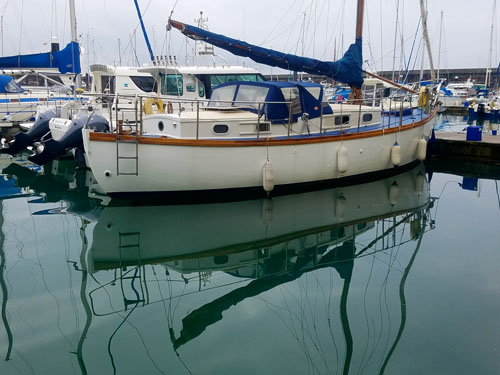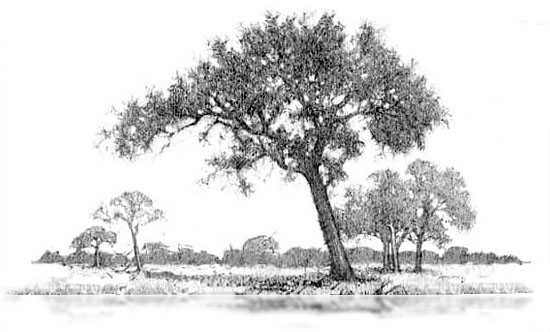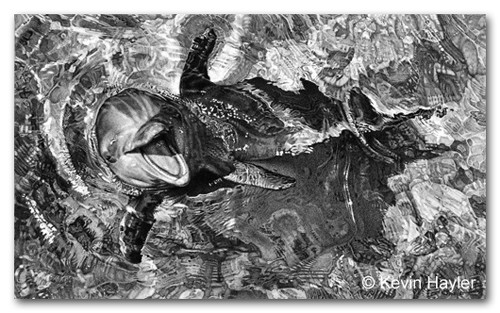Ways to Draw Water in Plan View

Many artists find drawing h2o difficult still, as with most techniques, there are guidelines to follow. If you lot want to know how to draw water, I can show you what I do. In brusk…
In water, darker shapes will reflect lighter, and lighter shapes volition reflect darker. Water will appear darker than the sky. Reflections reveal the undersides of an object and not the reverse epitome. And finally, h2o reflections always lose particular.
Armed with a few simple 'rules', let's come across how they piece of work in exercise.

(I become commissions for purchases made through links in this postal service. Notwithstanding, I only promote products I like and recommend)
How to Draw Water Reflections
Reflections in even so h2o are the easiest to depict. The 'rules' apply conspicuously without all the complications of moving shapes.
A night bank of trees reflecting in a still lake will appear lighter in the reflection. The value of the reflection volition alter depending on the color of the water, but the rule remains constant.
The reverse is true when light objects reflect. They announced darker in the reflection. A white boat, for example, will reflect as grey.
THE RULES OF Water REFLECTIONS

N.B. Water reflections are rarely the exact reverse image of the subject
Let's presume we are adding some trees to a landscape, set dorsum from the water's edge. There is some land in-between the trees and the h2o. If we were to flip the trees over from the base, only a portion of the reflection would cross the waterline.
Now let's look at a unproblematic mural and work out where the reflections would be. This is a quick sketch I made to demonstrate the rules, such equally they are.

STEP i: I sketched a clump of trees in a landscape and drew an imaginary waterline. An amateur would flip the whole scene and draw the reflection, like a mirror, but this is not quite what I practice.

STEP 2: The first thing I had to do was indicate a riverbank. I drew a slim reflection along the waterline. I diffused the detail.

STEP 3: I flipped the tree reflection vertically, blurred the particular, and lightened the tone slightly. It's important that the reflection starts from the base of the tree.

Stride 4: I practice exactly the same affair with the clump of copse to the right. I flipped them over, from the base, and because they are further away, the refection crosses the waterline college upwards. You can only run into the foliage.

Footstep 5: I repeat the process on the left. The crown of the bare tree is conspicuously visible in the water, but the far tree is only just showing. You'll notation that the horizon line doesn't announced as a reflection at all.

Footstep 6: To add some authenticity I added a grey gradient to the water. Light skies reflect darker in water and make the scene await life-like.
Related mail: How to Draw a Woods Background the Easy Way
Given that I've created this landscape out of my imagination, it looks reasonably authentic. Few would claiming the perspective. Withal, there is ane element that is incorrect, but we need to use another example to highlight the issue.
Let's apply the example of an animate being, in this instance, a toy sheep!
There is no need to draw it. A photograph will show you how reflections work in reality.
Your eye-line will normally be above the waterline. The reflection volition be exactly vertical, but, and this is important, information technology'southward not a mirror epitome. The reflection volition reflect the UNDERSIDE of the animal.
THE RULES OF Water REFLECTIONS

Look at the sheep on the left above. You can see the underbelly and the underside of the chin. Practise you lot meet? And the reflection starts at the base of the subject. That's crucial to sympathise and to come across how reflections work.
Dissimilarity that with the reflection on the correct with an verbal mirror image. Do yous see how the perspective is wrong? But one foot reflects from the base. There are gaps between the other feet and the start of their reflections.
Using geometry to work things out, with perspective lines and vanishing points, doesn't help you to figure out what the underbelly looks like. For that, y'all'll demand a reference.
Here's another case of a reflection using one of my drawings.

Find how the tiger's reflection is foreshortened. I viewed the tiger from above, from a distance. The whites are noticeably darker in the reflection and I've simplified the ripples. In real life, there were reflections everywhere. I distilled the image down to the most important shapes.
When I'm stuck I attempt to find a photo online that matches my needs. I might, if I'g lucky, have an paradigm buried somewhere in my 'archive' of rejected shots. If not, it'south onto Instagram and Google to try and find something similar. The search can be frustrating.
I like to relieve images every bit they present themselves when I find them. If I come beyond an image that reminds me of a photo I've taken in the past, I will save it. I might demand the reference at some point in the future. Information technology's my digital scrapbook of potentially useful stuff.
It'south skillful practice to have a scrapbook file, you should start one.
Nearly artists use photographs. If it worries you lot read this: Is Cartoon From Reference Photos Bad? Are Y'all Cheating?
Yous should be selling your art! What's stopping you? If yous need a helping paw, I can bear witness you how to exercise it, Step-past-Step!

If You lot Want to Sell Your Art
Cheque this out!
Psst…it's only $12.99!
How to Draw Water Droplets and Splashes
One await at a moving picture with water splashing everywhere and the idea of cartoon it can be overwhelming. Information technology is, even so, i of the easier effects to master. Information technology's all technique.
Again it'due south easier to use an example to demonstrate my point. Permit's take a await at this bad boy.

It might look photographic, simply that doesn't hateful I copied everything super accurately. I was more interested in getting the event to look good. Near enough was good enough.
My priority was to draw the shark also as I could before I attempted the h2o. When I was happy enough with the manner it was going I started to cake in the sea using an HB, 0.3mm Pentel Mechanical Pencil (affiliate)
This is how I utilize them and then effectively: Can Yous Describe With Mechanical Pencils? Yes, and Here's How
A mid-grey base tone was all I needed.
I darkened the obvious black patches with a B grade and and then it was a affair of 'lifting out' the tones using a combination of erasers.
- I used a Tombo Mono Eraser Pen (affiliate) for the smaller ripples,
- A Faber Castell Kneadable Eraser (affiliate) for larger areas using it to dab the paper lightly,
- Blu Tack (affiliate) to printing against the graphite and elevator clean patches of graphite without smudging
- A Jakar Battery Eraser (affiliate) to lift the sparkling highlights
I went back and along, erasing, shading, and erasing until I was confident that everything looked accurate and counterbalanced.
I'1000 glad I managed to keep the black water looking clean and polish. I resisted the temptation to add more than tones. The dissimilarity between the evidently simplicity of the darks against the complexity of the surf makes the image much stronger.
This is how I finish my drawings from smudging: Forbid Your Drawings From Smudging: The Ultimate Guide
Amateurs often assume that experts know exactly what they're doing at all times, merely that's not the case. At that place is a lot of trial and error and calculated guesswork. Don't exist too concerned if things go wrong. Step back and take a interruption. You can unremarkably pinpoint your errors when you lot return with fresh eyes.
The icing on the block happens when you employ the battery eraser to describe the dots and squiggles at the end and the water starts to movement.
By breaking down the drawing into stages, starting with the darker tones and progressively 'lifting out' lighter areas, a seemingly incommunicable chore is made doable.

Drawing the droplets, in this drawing of a jaguar, was very satisfying. To exercise the same, accept a battery eraser and make random dots. Don't make them all perfectly round, draw wonky shapes, and add tails to some of the drips.
Shade the droplets by making one side night and the opposite light. I left a thin white rim surrounding the edge. Now highlight the dark side, with a dot of white, using the eraser pen. Yous now take a very realistic h2o splash. Don't forget to draw all the highlights coming from the aforementioned direction.
The Skillshare course (chapter) below is non mine merely it demonstrates how to draw h2o aerosol if you want to learn by video.
How to Draw Water Ripples
In stark contrast to the previous drawings of water which look so challenging, only were relatively piece of cake, the next example of a duckpond was insanely hard to draw.
It'due south always the same, whenever I become over-confident, I'm brought back to globe with a bump. I assumed that drawing water ripples would be easy, information technology was anything but.

The duck itself was reasonably straightforward. I used hard pencils to depict in the subtle greys of the plumage and 'lifted out' the highlights. This is my usual method.
The h2o reflection of the duck was fairly easy every bit well. The issue I had was making the shapes align realistically. They were, in fact, more distorted in real life and didn't look quite right. I shifted them slightly.
If you like realism check this out: How to Draw Realistically: eleven Good Tips For Height Results
Drawing the water ripples was a total pain. I went incorrect primarily by choosing textured newspaper instead of a shine surface.
I wasn't going to requite up and beginning again because I'd spent likewise much fourth dimension drawing the duck already. My chore was to depict a smooth water surface without the grain showing. As yous tin encounter that was only partly successful.

Heaven knows why I drew such a pocket-sized grid. This is a very simple shape to cake in. I used mainly very hard pencils for drawing the feathers.

You tin can see that the lite feathers are reflecting darker in the h2o. I established the darks beneath the duck. I started to draw in the elliptical shapes and began to struggle. I tried to alloy the tones with different grades of pencils.

I struggled because I was fighting the paper and refused to smudge the graphite. For years I resisted blending pencil thinking that it was a pointless technique used only by amateurs, I was incorrect. All I did was brand work for myself.

The water ripples in the foreground are sharper than those in the background. I had to lose detail in the distance. Y'all'll too notice that in that location is a slight gradient, first with a darker tone at the front end which gets progressively lighter every bit it recedes.
A quick 55-2nd video of the duck and h2o ripples existence drawn
We all become these ideas about the right and incorrect to apply your medium and they can be hard to milk shake off. I should've used a cotton bud to gently smooth the surface, instead, I used diverse grades of pencil and tried to blend them 'skillfully'.
Yous can't use the right pencil on the incorrect paper. Read this: What's The Correct Paper for Pencil Drawing? (How to Choose Wisely)
To add to my difficulties, I had to draw precise elliptical water ripples, each with its own gradients. I had no thought that drawing ellipses would be that difficult. If I was but a fraction out of line, the water illusion was lost.
I had to describe concentric ellipses, perfectly aligned, perfectly spaced, and with perfect gradients and tone. Information technology collection me nuts, and I was constantly picking at anomalies and devious specks appearing in the paper grain.
This drawing represents i of the classic problems artists feel when they are continually 'rescuing' their artwork.
After investing so much time and effort, with some notable successes forth the way, everything becomes far also precious. Fear sets in and y'all get agape of losing all your gains. The fear itself inhibits y'all from making the right changes and you get stuck.
I suppose the main lesson I've learned is to choose your paper advisedly and don't get complacent.
How to Draw Articulate Water
The fun starts when yous want to draw something in clear water. Not only have yous got water reflections bouncing around, just you likewise have the body shape and shadow, all in i chaotic paradigm.
I won't kid you, it's daunting, and every fourth dimension I have pushed myself to the challenge, I've sworn I'll never do information technology again. The image below is a case in point.

The central to drawing crystal clear water is to emphasize contrasts. The sparkles look all-time against the black background. You can see that more clearly below the dorsal fin. The ripples on the far left look good for the same reason.
It'southward vital to retain the white highlights if the transparency is to exist disarming. To that stop, I made a huge endeavour not to smudge the surface of the newspaper in whatsoever way.
Nowadays I would 'lift' the whites out with a battery eraser, merely I drew this many years ago and painstakingly drew around the dots, one past i.
Equally I couldn't apply color to separate elements in the image I retained the grain in the paper to point the sandy seabed while smoothing the dolphin'due south skin with a newspaper stump. The dolphin stood out more in my colored photo, merely in monochrome, I had to use more contrast to have the same impact.
I too had to make information technology clear that the caput was above the water. Only the top of its caput is in perspective. The residue of the body underwater is distorted beneath the ripples.
It can be a challenge to draw a convincing animal underwater when viewed from to a higher place, the refractions may look groovy in a photo but bizarre in an illustration. Some judicious corrections may be required.
In that location are lots of drawing hacks to improve your piece of work: How to Make Your Drawings Interesting: fourteen Ways to Improve a Drawing
Practise you lot lack conviction? Have a class and become into the habit of drawing. I plant this class on Skillshare (affiliate), 75436 students can't exist incorrect!
It's not quite the same, but I can demonstrate the departure between reality vs artistic license with the penguin drawing below.

The drawing on the left is an sometime sketch of a penguin, seen through a tank in the Singapore Zoo. The dislocated head on the right side is how the photograph (long since lost) actually looked. The head appears separated.
You can imagine the looks of defoliation if I'd presented the one on the right for sale as a finished drawing? No i would buy it.
Demand help with getting started? Read this: How to Plan and Etch Your Art: A Guide for Beginners
The final epitome I will share with you is likewise a drawing I did of a river otter. I did it many years agone.

The claiming was to make the body visible in a mass of rippling water. I drew each ripple i past one. As with the dolphin drawing above, there was almost no 'lifting out' with an eraser. I drew this earlier I'd established whatsoever real technique. I was however experimenting.
It's simply the nighttime shapes at the sides that give form to the body, and the slightly lighter belly. I practice recollect readjusting the tones over and over again to get the balance right. It was simply when I was in danger of ruining the paper that I stopped.
If disaster strikes read this post: How to Repair Drawing Paper: ix Ways to Rescue Your Artwork
Drawing H2o – Final Thoughts
Drawing water doesn't demand to be then painful if you approach it in the right way. Think the guidelines at the beginning. They volition aid a lot. Use your eraser to draw water and the most complex effects will be and so much easier to achieve.
Now you know how to describe water in pencil – probably.
This is my bones drawing kit if you lot want to endeavor things out for yourself: (Amazon chapter links)
- Pentel Mechanical Pencils 0.3mm
- Derwent Graphic Drawing Pencils
- Daler-Rowney Heavyweight Cartridge Paper
- Jakar Battery Eraser
- Tombo Mono Eraser Pen
- Faber Castell Putty Eraser
- Blu Tack
If you lot want an culling art supplier, check out ARTEZA (affiliate)

If yous can tackle cartoon water, it's time to sell your fine art. If you wanna live your dreams and make a living, you lot need to check out this guide!

If You Want to Sell Your Art
Bank check this out!
Psst…information technology's only $12.99!
There are more tutorials like this, take a await at:
- How to Describe Realistic Shadows in Pencil (All the Secrets)
- How to Draw White Lines in a Pencil Drawing (Without Going Mad)
- Tracing Art – Is Information technology Good or Bad? When Is Tracing Cheating and Is It Ever OK?
- How to Describe Texture in Pencil: 6 Tips to Become Results – FAST
- How to Protect and Preserve Your Drawings and Avoid Disaster
- How to Scale Up a Drawing in four Like shooting fish in a barrel Means and Save Fourth dimension
Plus observe an ONLINE COURSE that suits y'all.
PIN Information technology AND SAVE IT

Source: https://www.wildlifeartstore.com/how-to-draw-water-in-pencil/
0 Response to "Ways to Draw Water in Plan View"
Postar um comentário